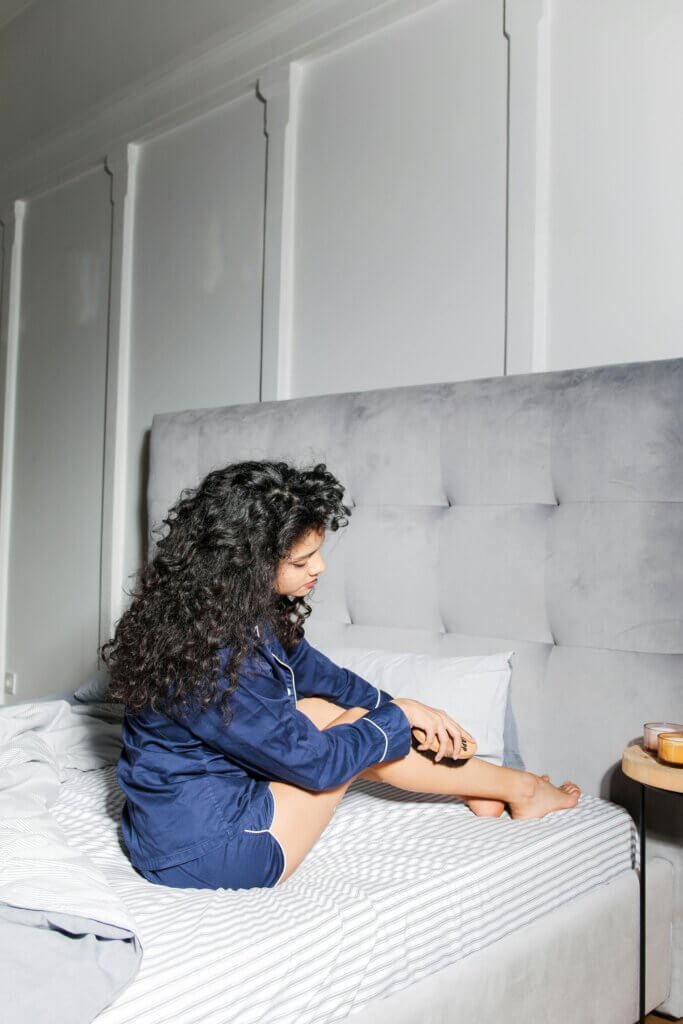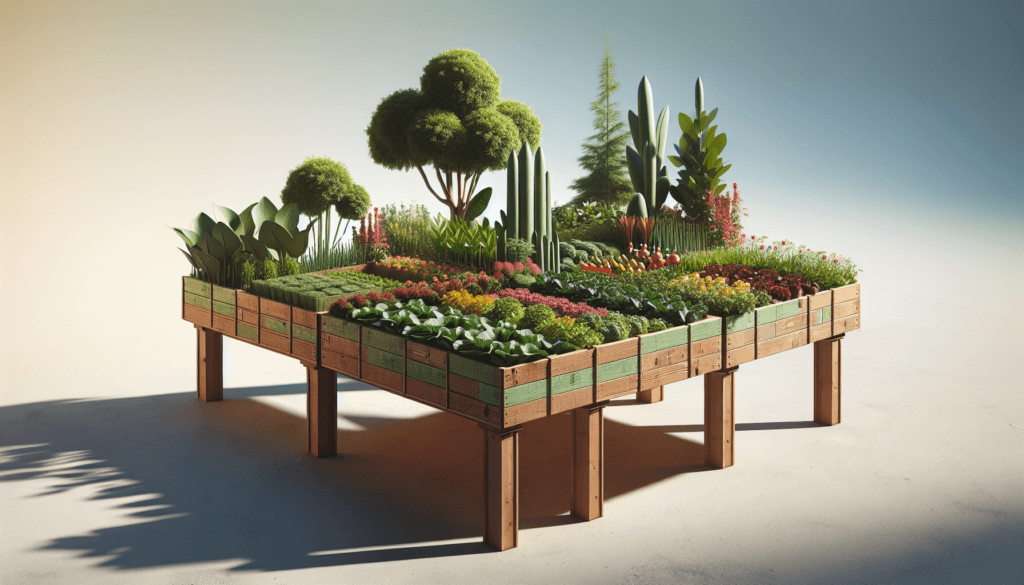If you’re a gardening enthusiast looking to take your gardening experience to new heights, quite literally, then creating a raised garden bed with legs might just be the project you’re looking for. In this article, we’ll explore the most popular DIY projects that will help you create a raised garden bed with legs. From basic designs to more intricate and unique ideas, these projects are sure to inspire and elevate your garden to new levels. So get ready to roll up your sleeves and discover the wonderful world of raised garden beds with legs.

1. Materials and Tools
When it comes to creating a raised garden bed with legs, it’s important to gather all the necessary materials and tools beforehand to ensure a smooth and efficient construction process.
1.1 Preparing the Materials
The first step is to gather the materials needed for building the raised garden bed. You will require wood or other suitable materials for the frame, screws or nails for securing the pieces together, and a weed barrier to place at the bottom of the bed to prevent unwanted growth. Additionally, you may want to consider using hardware cloth to keep out pests.
1.2 Gathering Necessary Tools
In order to build the raised garden bed with legs, you will need a few essential tools. These include a measuring tape, a saw for cutting the wood or other materials to size, a drill or hammer for assembling the bed, and a level to ensure that the bed is properly balanced. Don’t forget to have safety gear such as gloves and safety glasses to protect yourself during the construction process.
2. Choosing the Right Location
Selecting the proper location for your raised garden bed is crucial for the success of your plants. Consider the following factors before deciding on a spot:
2.1 Evaluating Sunlight
Most plants require adequate sunlight to thrive, so it’s important to choose a location that receives at least six hours of direct sunlight per day. Observe the area throughout the day to determine the amount of sunlight it receives. Avoid areas that are heavily shaded by trees or buildings.
2.2 Considering Drainage
Good drainage is essential for the health of your plants. Look for a spot that slopes slightly to allow excess water to drain away. Avoid areas that are prone to flooding or have poor drainage, as these can cause rot and waterlogged soil.
2.3 Accessibility and Convenience
Choose a location that is easily accessible for maintenance and harvesting. Consider the proximity to a water source for convenient watering. It’s also wise to place the raised bed in a location that is close to your kitchen or a designated outdoor leisure area for easy enjoyment and monitoring.

3. Building a Basic Raised Garden Bed with Legs
Once you have gathered all the necessary materials and chosen the perfect location, it’s time to start building your raised garden bed with legs. Here are the steps you’ll need to follow:
3.1 Measuring and Marking
Start by measuring and marking the desired dimensions of your raised garden bed. Use a measuring tape and wooden stakes to outline the area. This will help you determine the amount of materials you’ll need and ensure a symmetrical and well-proportioned bed.
3.2 Constructing the Frame
Cut the wood or other materials to the desired lengths for your bed’s frame. Assemble the pieces using screws or nails, making sure the corners are square and the frame is sturdy. Use a level to ensure that the bed is even and balanced.
3.3 Adding Legs for Height
To create a raised garden bed with legs, attach four legs to the bottom of the frame. Choose legs that are sturdy and can support the weight of the soil and plants. Secure the legs to the frame using screws or nails, ensuring they are evenly spaced and at the desired height.
3.4 Reinforcing and Securing
To ensure the stability and longevity of your raised garden bed with legs, reinforce the corners and edges with additional screws or nails. This will prevent the frame from shifting or collapsing over time. Consider adding extra support beams or braces for larger or longer beds.
4. Utilizing Recycled Materials for a Sustainable Garden Bed
If you’re looking for an eco-friendly approach to building your raised garden bed with legs, consider using recycled materials. Not only is this a sustainable choice, but it can also add unique and rustic charm to your garden. Here are a few ideas to get you started:
4.1 Reclaimed Wood or Pallets
Reclaimed wood or pallets can be repurposed to create a beautiful and functional raised garden bed with legs. Look for discarded wood materials or pallets that are in good condition and free of harmful chemicals. Sand and treat the wood if necessary, and follow the same construction process as mentioned earlier.
4.2 Repurposed Containers
Think outside the box and repurpose containers into raised garden beds with legs. Consider using old wine barrels, metal drums, or large plastic containers. Make sure to drill drainage holes at the bottom and add legs for elevation. These unique containers can add a touch of character to your garden while reducing waste.
4.3 Upcycled Concrete Blocks
Another creative and sustainable option is to upcycle concrete blocks. Stack the blocks to create raised beds of varying heights and attach legs to elevate them further. The hollow spaces in the blocks can also be filled with soil, allowing for additional planting areas. This versatile material can give your garden a modern and industrial look.

5. Portable Raised Garden Beds with Legs
If you have limited space or want the flexibility to move your garden bed around, consider building a portable raised garden bed with legs. These beds offer convenience and versatility. Here’s how you can create one:
5.1 Using Lightweight Materials
Use lightweight materials such as plastic or fabric containers, or even PVC pipes, to construct a portable raised garden bed. These materials are easy to move around and require minimal effort to assemble and disassemble. They are also ideal for balcony gardens or urban settings with limited space.
5.2 Incorporating Wheels or Casters
To enhance the portability of your raised garden bed with legs, add wheels or casters to the bottom of the frame. This allows you to effortlessly move the bed to different locations, depending on sunlight or weather conditions. Make sure to choose sturdy wheels that can withstand the weight of the soil and plants.
5.3 Adjustable Height Options
Consider incorporating adjustable height options into your portable raised garden bed. This allows you to raise or lower the bed according to the growth stage and needs of your plants. Adjustable legs or a telescopic design can provide the flexibility to accommodate different plant varieties and ensure optimal growing conditions.
6. Raised Garden Beds with Legs for Small Spaces
If you have limited outdoor space, don’t let that stop you from enjoying the benefits of a raised garden bed. Here are some ideas for creating raised garden beds with legs that are perfect for small spaces:
6.1 Vertical Designs
Vertical garden beds are a fantastic option for small spaces. These beds utilize vertical space, allowing you to grow a variety of plants in a compact area. Construct the frame with sturdy materials and attach it to a wall or fence. Add shelves or pockets to hold multiple plants, maximizing the use of limited space.
6.2 Hanging Garden Beds
Hanging garden beds are another great solution for small spaces, as they take advantage of unused overhead space. Use hooks or brackets to suspend the beds from a sturdy structure, such as a pergola or balcony railing. Hang baskets or containers filled with soil and plants, ensuring proper drainage and support.
6.3 Stackable and Tiered Options
Opt for stackable or tiered raised garden beds with legs to make the most of your limited space. These beds allow you to create multiple levels for planting, providing ample growing space within a small footprint. Choose materials that are both lightweight and sturdy, ensuring the stability of the structure.

7. Customizing Your Raised Garden Bed with Legs
Take your raised garden bed with legs to the next level by customizing it to suit your specific needs and preferences. Here are a few ideas to consider:
7.1 Adding Trellises or Supports
If you plan to grow climbing or vining plants, consider incorporating trellises or supports into your raised garden bed design. Attach these structures to the back or sides of the bed to provide support for the plants as they grow. This not only adds visual interest but also maximizes vertical growing space.
7.2 Installing Drip Irrigation Systems
To simplify watering and ensure that your plants receive adequate moisture, install a drip irrigation system in your raised garden bed. This system delivers water directly to the plants’ roots, reducing water waste and minimizing the risk of overwatering. Automating the watering process saves you time and effort.
7.3 Incorporating Planting Containers
For added versatility and ease of maintenance, consider incorporating planting containers within your raised garden bed with legs. This allows you to easily swap out or rearrange plants as needed. Use plant pots, grow bags, or other suitable containers that fit within the dimensions of the bed.
7.4 Applying Finishes or Paint
Add a personal touch to your raised garden bed by applying finishes or paint. Choose finishes that protect the wood or other materials from weathering, such as varnish or waterproof sealants. Alternatively, opt for an exterior paint that complements your outdoor space or adds a pop of color to your garden.
8. Raised Garden Bed Accessories and Additions
Enhance the functionality and longevity of your raised garden bed with legs by considering useful accessories and additions. Here are a few options to explore:
8.1 Garden Bed Covers and Protection
Protect your plants from extreme weather conditions, pests, and diseases by using garden bed covers. These covers act as a shield, providing protection while still allowing sunlight and air circulation. Choose covers made from durable materials that can withstand outdoor elements.
8.2 Composting Systems
Create a sustainable garden ecosystem by incorporating composting systems into your raised garden bed. Compost bins or worm farms can be placed beneath the bed, utilizing the space effectively. This allows for convenient composting and provides nutrient-rich soil amendments for your plants.
8.3 Pest Control Measures
Prevent pests from damaging your plants by implementing pest control measures in and around your raised garden bed. This can include installing physical barriers, such as netting or fences, using organic pest repellents, or attracting beneficial insects to naturally control pests. Regular monitoring and early intervention are key to maintaining a healthy garden.

9. Maintenance and Care for Raised Garden Beds with Legs
Proper maintenance and care are essential for the long-term success of your raised garden bed with legs. Follow these guidelines to ensure your plants thrive:
9.1 Soil Amendments and Fertilization
Regularly amend the soil in your raised garden bed with organic matter to maintain nutrient levels. Compost, worm castings, or aged manure can be added to enrich the soil. Additionally, consider periodic fertilization with a balanced organic fertilizer to provide essential nutrients for optimal plant growth.
9.2 Watering and Drainage Maintenance
Monitor the moisture levels in your raised garden bed and water accordingly. Provide sufficient water to keep the soil evenly moist, but avoid overwatering, as it can lead to root rot. Regularly check the drainage system to ensure it is functioning properly and make adjustments if needed.
9.3 Weed and Pest Management
Stay vigilant in controlling weeds in your raised garden bed. Regularly remove any weeds that appear to prevent competition for nutrients and minimize the risk of pests. Implement a proactive pest management plan, such as handpicking pests, using organic insecticidal soaps, or introducing beneficial insects.
9.4 Seasonal Storage and Protection
If you live in an area with harsh winters or extreme weather conditions, consider seasonal storage and protection for your raised garden bed with legs. Move the bed to a protected area or cover it with a tarp during the offseason. This helps to maintain the structural integrity of the bed and protects it from damage.
10. Inspiration and Ideas for Raised Garden Beds with Legs
Looking for inspiration to create your own unique raised garden bed with legs? Here are some ideas to fuel your creativity:
10.1 Creative Shapes and Designs
Think beyond the traditional rectangular shape and experiment with creative shapes and designs. Consider circular, triangular, or even zigzag patterns for your raised garden bed. These unique designs not only add visual interest but also provide distinct planting areas for different types of plants.
10.2 Versatile Planting Configurations
Explore versatile planting configurations that allow you to grow a variety of plants within a single raised garden bed. Incorporate dividers or partition walls to separate different plant species or create microclimates within the same bed. This can help optimize growing conditions and increase plant diversity.
10.3 Showcasing Ornamental Plants
Why not make your raised garden bed a centerpiece of your outdoor space by showcasing ornamental plants? Choose vibrant flowers, colorful foliage, or cascading vines to create a visually stunning display. Add decorative elements such as trellises, garden sculptures, or fairy lights to further enhance the beauty and ambiance of your garden.
With the right materials, tools, and a little creativity, you can create a raised garden bed with legs that suits your space, style, and gardening needs. Whether you opt for a basic design, a sustainable approach, or explore unique configurations, your raised garden bed will not only provide a functional growing space but also be a beautiful addition to your outdoor oasis. Happy gardening!


